
Categories:
Environmental Factors And Durability Of Gun Magazines
Gun magazines, also known as gun magazines or clips, play a crucial role in the functioning and reliability of guns. These devices store ammunition and feed it into the gun’s chamber, enabling rapid and efficient firing. While much attention is often given to the durability and performance of guns themselves, the significance of gun magazines should not be overlooked.
In order to understand the environmental factors that can impact gun magazine durability, it is essential to first grasp their basic construction. A typical gun magazine consists of a metal or polymer casing with a spring-loaded follower mechanism inside. The follower pushes rounds of ammunition upwards toward the gun’s chamber, ensuring smooth feeding during firing.
One key environmental factor that affects gun magazine durability is moisture. Exposure to high humidity or direct contact with water can cause rusting or corrosion on metal components, compromising their functionality over time. Additionally, moisture can lead to damage in polymer-based magazines by degrading their structural integrity.
Temperature variations also pose significant challenges for gun magazine durability. Extreme cold temperatures can cause materials like polymers to become brittle and prone to cracking under stress. Conversely, excessive heat can soften polymers or deform metal components, negatively impacting feeding reliability.
Furthermore, exposure to dust and debris is another important consideration when evaluating the durability of gun magazines. Fine particles can infiltrate the magazine’s internal mechanisms or accumulate on its surfaces over time, hindering smooth movement of ammunition and potentially causing malfunctions during critical moments.
Understanding these environmental factors and their impact on gun magazine durability is essential for gun owners who rely on their weapons for self-defense purposes or professional use. By considering these factors when selecting and maintaining their gun magazines properly, gun users can ensure optimal functionality even under challenging conditions.
When it comes to evaluating the durability of gun magazines, it is crucial to consider the various environmental factors that can significantly impact their performance and longevity. These factors encompass both natural elements and human-induced conditions that a magazine might encounter during its lifespan.
One of the primary environmental factors influencing the durability of gun magazines is temperature. Extreme temperatures, whether excessively hot or cold, can have adverse effects on their materials and overall functionality. For instance, exposure to high temperatures may cause polymer-based magazines to warp or deform, compromising their structural integrity. Conversely, extremely low temperatures can render metal components brittle and prone to breakage.
Humidity levels also play a crucial role in determining the durability of gun magazines. High humidity environments can lead to rust formation on metal components, particularly if they are not adequately protected or coated with anti-corrosion agents. Moisture absorption may also affect polymer-based magazines by causing them to swell or become more susceptible to cracking.
Another significant factor is exposure to UV radiation from sunlight. Prolonged exposure can cause discoloration and degradation of plastic components in gun magazines over time. Additionally, UV radiation may weaken adhesives used in magazine construction, leading to delamination or failure at critical points.
Dust and debris accumulation should not be overlooked when considering environmental impacts on magazine durability. In dusty environments or during prolonged use without maintenance, particles can infiltrate moving parts such as springs and followers, hindering smooth operation and potentially causing malfunctions.
Lastly, human-induced conditions like improper storage practices or mishandling should be taken into account. Storing loaded magazines under constant compression for extended periods might result in spring fatigue or loss of tension over time.
Understanding these environmental factors is crucial for manufacturers and users alike when assessing the durability of gun magazines. By identifying potential weaknesses arising from specific conditions, appropriate measures can be implemented for designing more resilient products that withstand diverse environments effectively.
When it comes to guns, particularly handguns and rifles, the durability of gun magazines is a crucial factor that should not be overlooked. A gun magazine serves as a container for ammunition, ensuring that rounds are reliably fed into the gun’s chamber. It is an essential component that directly affects the weapon’s performance and functionality. Therefore, understanding the significance of durability in gun magazines becomes paramount.
Firstly, durability ensures reliable feeding and extraction of ammunition. In high-stress situations where split-second decision-making is required, malfunctions caused by faulty or poorly constructed magazines can be catastrophic. A durable magazine guarantees smooth operation, reducing the risk of jams or misfeeds that could potentially hinder a shooter’s ability to defend themselves or others. Secondly, durability directly impacts the lifespan and cost-effectiveness of gun magazines.
Guns enthusiasts and professionals alike invest substantial amounts of money in their weapons and accessories. A magazine that withstands repeated use without significant wear or damage will prove more cost-effective in the long run compared to one that requires frequent replacements. Moreover, factors such as exposure to extreme temperatures, moisture, dust particles, and other environmental conditions can significantly affect a magazine’s reliability over time.
Durability plays a vital role in mitigating these external influences on both internal components and external surfaces. Furthermore, law enforcement officers and military personnel heavily rely on their guns for self-defense and protection during critical operations. In such demanding scenarios where lives may depend on the proper functioning of their equipment, durable magazines become indispensable tools they can trust with their lives.
In conclusion, durability is an indispensable characteristic when it comes to gun magazines due to its impact on reliability during critical moments when every shot counts.
Temperature is a critical environmental factor that significantly affects the performance and durability of gun magazines. Fluctuations in temperature can lead to various issues, including deformation, reduced functionality, and even catastrophic failure of these essential gun components.
Extreme cold temperatures pose significant challenges for gun magazines. The metal used in magazine construction contracts when exposed to extreme cold, causing the magazine body and feed lips to become rigid and brittle. As a result, the magazine may become prone to cracking or breaking under stress, compromising its overall durability and reliability. Furthermore, the contraction of metal components can affect ammunition feeding dynamics by causing increased friction or misalignments within the magazine.
On the other hand, high temperatures also impact magazine performance. Heat causes metals to expand, potentially leading to dimensional changes in critical parts such as feed lips or followers. Distortion or warping caused by heat can result in malfunctions like failure to feed or improper cartridge alignment within the gun’s chamber. Additionally, prolonged exposure to high temperatures may cause lubricants inside the magazine to evaporate rapidly, leading to increased friction between moving parts.
It is crucial for gun users and manufacturers alike to consider temperature ranges when designing or selecting gun magazines for specific applications. Magazines specifically engineered with materials that resist extreme temperatures are often preferred for use in environments where temperature fluctuations are expected.
To ensure optimal performance and longevity of gun magazines under varying temperature conditions, regular maintenance becomes imperative. This includes inspecting for cracks or deformations before use and applying appropriate lubrication suitable for prevailing temperatures.
In conclusion, temperature has a substantial impact on gun magazine performance and durability. Understanding these effects enables gun users and manufacturers alike to make informed decisions regarding proper selection, maintenance practices, and material choices when it comes to ensuring reliable operation even under extreme environmental conditions.
Humidity, the amount of moisture present in the air, plays a crucial role in determining the durability and functionality of gun magazines. The impact of humidity on guns is well-documented, but its effects specifically on gun magazines are equally significant.
One of the primary concerns with high humidity levels is the potential for moisture absorption by gun magazines. Most gun magazines are made of metal, which can be prone to rusting and corrosion when exposed to moisture for extended periods. When humidity levels rise, especially in environments lacking proper ventilation or storage conditions, there is an increased risk of water vapor condensing on metal surfaces.
This can lead to rust formation and subsequent damage to the magazine’s structural integrity.
Furthermore, high humidity can also affect magazine springs. These springs are responsible for feeding ammunition into the gun reliably and consistently. Excessive moisture in the air can cause corrosion or oxidation on spring surfaces, resulting in reduced tension or even failure over time. This compromises the overall performance of a gun by potentially causing misfeeds or jams during critical moments.
In regions with consistently high humidity levels or during seasons where atmospheric moisture content rises significantly, it becomes imperative for gun owners to take preventive measures. Storing gun magazines in a controlled environment with low humidity levels is crucial to maintaining their durability over time.
To mitigate these risks associated with high humidity levels, many gun enthusiasts utilize various protective measures such as storing gun magazines inside sealed containers with desiccants or utilizing dehumidifiers within their storage spaces. Regular inspections and cleaning routines should also be implemented to identify any signs of rust formation or damage caused by excess moisture promptly.
In conclusion, understanding how humidity impacts gun magazines is essential for responsible gun ownership. By recognizing these environmental factors and taking appropriate precautions, individuals can ensure that their gun magazines remain durable and reliable throughout their lifespan.
Gun magazines are essential components of guns that require proper care and maintenance to ensure their durability. One critical aspect of maintenance is preventing corrosion and rust formation, as these can significantly affect the functionality and lifespan of the magazine. Several measures can be taken to protect gun magazines from these environmental factors.
Firstly, it is crucial to store gun magazines in a dry environment. Moisture is one of the primary causes of rust formation, making it imperative to keep magazines away from damp areas or excessive humidity. Consider using a dehumidifier in storage spaces or utilizing moisture-absorbing agents like silica gel packets to maintain optimal humidity levels.
Another effective measure is applying a protective coating to the magazine’s exterior surfaces. Various types of coatings, such as bluing, Parkerizing, or Cerakote finishes, provide an additional barrier against moisture and corrosion. These coatings not only enhance aesthetics but also provide excellent protection against rust formation.
Regular cleaning plays a vital role in preventing corrosion as well. After each use or exposure to harsh environments, it is recommended to thoroughly clean the magazine with an appropriate solvent and lubricant specifically designed for guns. This helps remove any dirt, debris, or corrosive agents that may have accumulated on the surface.
Furthermore, maintaining proper lubrication on moving parts within the magazine can help prevent rust by reducing friction and protecting against moisture intrusion. A thin layer of high-quality lubricant applied at regular intervals ensures smooth operation while acting as a shield against potential corrosion.
Lastly, periodically inspecting magazines for signs of wear or damage is important for their long-term durability. Any cracks or chips should be addressed promptly by replacing damaged parts or seeking professional assistance if necessary.
By implementing these corrosion prevention measures into regular maintenance routines, gun owners can significantly extend the lifespan and reliability of their gun magazines even when exposed to challenging environmental conditions.
Gun magazines are essential components of guns, responsible for feeding ammunition into the chamber and ensuring a reliable shooting experience. However, their durability can be greatly affected by environmental factors such as water exposure. This subtopic will explore the impact of water exposure on gun magazines and discuss measures to enhance their resilience. Water exposure poses a significant threat to the functionality and longevity of gun magazines.
When submerged or exposed to moisture, metal components within the magazine may corrode, leading to rust formation. Rust not only affects the aesthetic appeal of the magazine but also hampers its smooth operation. Corroded springs or followers can cause feeding issues, resulting in malfunctions or misfires during critical moments. To enhance the resilience of gun magazines against water exposure, manufacturers employ various strategies.
One common approach is utilizing high-quality materials resistant to corrosion, such as stainless steel or polymer composites that resist moisture absorption. These materials provide an additional layer of protection against rust formation when exposed to water. Additionally, some gun magazines feature specialized coatings that further safeguard them from water damage. For instance, certain coatings like nickel Teflon or Cerakote create a barrier between the metal surfaces and moisture, inhibiting corrosion and extending the magazine’s lifespan.
Proper maintenance is crucial for ensuring long-term durability in gun magazines subjected to water exposure. Regular cleaning and drying after use in wet conditions are essential steps in preventing rust formation and maintaining optimal performance. Applying a light coat of lubricant on metal parts can also help repel moisture and reduce friction during operation. In conclusion, water exposure significantly impacts the resilience and durability of gun magazines by promoting corrosion and rust formation.
Manufacturers mitigate this risk by using corrosion-resistant materials and specialized coatings while users must prioritize proper maintenance practices such as cleaning and drying after use in wet conditions.
When it comes to the durability of gun magazines, environmental factors play a crucial role. One of the most common challenges faced by gun owners is the accumulation of dust, dirt, and debris within the magazine. These elements can significantly affect the performance and reliability of guns. Therefore, it becomes imperative to protect gun magazines from such harsh environments. Dust particles are omnipresent in various shooting scenarios, especially in arid regions or indoor ranges with poor ventilation.
Over time, these tiny particles can infiltrate magazine components such as springs and followers. As a result, they may hinder proper feeding of ammunition or cause malfunctions during firing sequences. Similarly, dirt and debris pose another significant threat to magazine durability. Whether it’s loose soil on an outdoor range or remnants from cleaning solvents used during maintenance routines, these contaminants can easily find their way into magazines.
Once inside, they have the potential to cause jamming issues or interfere with the overall smooth operation of the gun. To protect gun magazines from dust, dirt, and debris in harsh environments, several preventive measures can be taken. One effective approach involves using protective covers specifically designed for magazines. These covers act as shields against external elements while still allowing easy access to ammunition when needed.
Regular cleaning and maintenance also play a pivotal role in preserving magazine longevity. By routinely disassembling and inspecting each component for accumulated dust or debris buildup, potential issues can be identified early on before they become problematic. Additionally, investing in high-quality magazines made from durable materials can enhance resistance against environmental factors. Manufacturers often employ advanced coatings or finishes that provide an extra layer of protection against dust infiltration and corrosion.
In conclusion, protecting gun magazines from dust particles, dirt accumulation, and debris is vital for ensuring their longevity and optimal performance in harsh environments.
While gun enthusiasts often focus on the mechanical aspects of guns, the environmental factors that affect their durability are just as crucial. One often overlooked threat to the longevity of gun magazines is UV radiation. This invisible force emitted by the sun can silently degrade and compromise these critical components.
UV radiation primarily affects gun magazines made from polymers, such as those commonly used in modern guns. Polymers are susceptible to photo-degradation, a process where prolonged exposure to UV rays causes chemical changes in their structure, leading to reduced strength and durability. The consequences of this degradation can be severe, compromising magazine function and potentially rendering them useless when needed most.
The harmful effects of UV radiation on gun magazines are particularly pronounced in regions with intense sunlight or for individuals who regularly expose their guns to direct sunlight during outdoor activities like shooting competitions or hunting trips. Even seemingly harmless exposure over time can accumulate damage and weaken polymer-based magazines.
To combat this hidden threat, manufacturers have started incorporating additives into the polymer compounds used in magazine construction. These additives act as UV stabilizers, absorbing or reflecting harmful UV rays before they can penetrate the material and cause damage. However, not all magazines possess these protective qualities.
To ensure your gun magazines remain durable over time, it is important to store them properly when not in use. Keeping them away from direct sunlight by utilizing protective cases or storing them indoors will minimize exposure to harmful UV radiation.
In conclusion, while we may not see it with our naked eyes, UV radiation poses a hidden threat to the longevity of gun magazines made from polymers. Understanding this environmental factor and taking appropriate measures such as storing them correctly will help preserve magazine durability and ensure reliable performance when it matters most
In conclusion, when it comes to selecting the right gun magazine for your environment, several important factors must be considered. The durability and reliability of a magazine are crucial to ensure optimal performance in various environmental conditions. Understanding how different environmental factors can impact the functionality of magazines is essential for making an informed decision.
Firstly, it is important to consider the climate and weather conditions in which you will be using your gun. If you frequently find yourself in humid or wet environments, choosing a magazine with corrosion-resistant materials such as stainless steel or polymer coatings can significantly enhance its durability. These materials offer excellent protection against rust and moisture damage, ensuring that your magazine remains functional even in adverse conditions.
Secondly, the physical demands of your environment should also be taken into account. If you anticipate rough handling or frequent drops, selecting a magazine with reinforced feed lips and sturdy construction is crucial. Magazines made from high-quality polymers or featuring metal reinforcements are more likely to withstand impact without compromising their functionality.
Additionally, considering the presence of dust, dirt, or debris in your environment is vital. In such cases, opting for magazines with self-cleaning features or easy disassembly can simplify maintenance and prevent malfunctions caused by foreign particles.
Lastly, evaluating the specific requirements of your gun and its compatibility with different magazines is essential. Researching extensively on which brands or models are known for their reliability under various environmental conditions can help narrow down your options.
By carefully considering these factors and understanding how they relate to your specific environment and gun needs, you can confidently choose a gun magazine that will deliver consistent performance and durability throughout its lifespan.
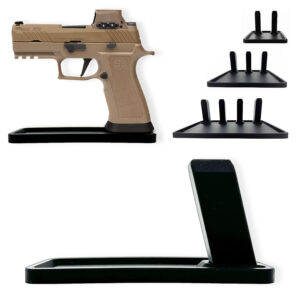
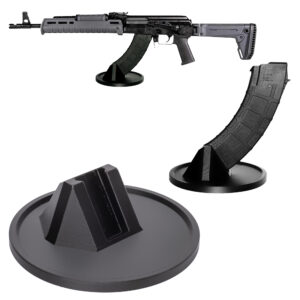


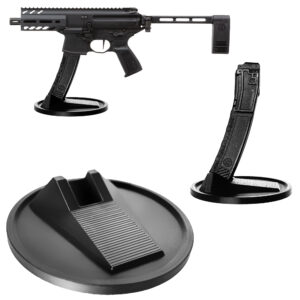
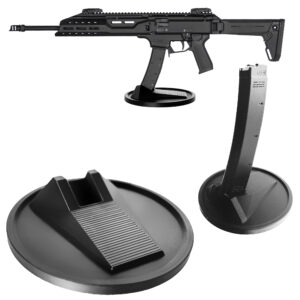

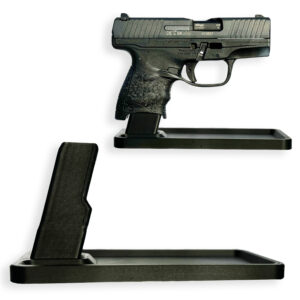
Colt
Colt M4 Carbine
Colt LE6920
Colt AR-15 A4
Daniel Defense
DDM4 V7
DDM4 V9
DDM4 V11
DDM4 ISR (Integrally Suppressed Rifle)
Smith & Wesson (S&W)
M&P15 Sport II
M&P15 Tactical
M&P15T
Bravo Company Manufacturing (BCM)
BCM Recce-16
BCM Recce-14
BCM MCMR Series
Aero Precision
M4E1 Series
AC-15
AR15 Pistol (Various Configurations)
Ruger
Ruger AR-556
Ruger SR-556
Ruger AR-556 MPR (Multi-Purpose Rifle)
Springfield Armory
Saint Victor
Saint Edge
Saint AR-15
PSA (Palmetto State Armory)
PSA PA-15
PSA AR-V
PSA Jakl (AR Pistol)
FN America
FN 15 Tactical Carbine
FN 15 Patrol
FN 15 DMR
Wilson Combat
Recon Tactical
Super Sniper
Protector Carbine
SIG Sauer
SIG M400 Tread
SIG M400 Elite
SIG M400 SDI
LWRC International
IC DI (Direct Impingement)
IC SPR
IC A5
Bushmaster Guns
XM-15 QRC
Bushmaster MOE
XM-15 Patrolman
Rock River Arms
LAR-15 Entry Tactical
LAR-15 Predator
LAR-15 Elite Comp
Stag Arms
Stag 15 Tactical
Stag 15L (Left-Handed Models)
Stag 15 Valkyrie
Noveske Rifleworks
Noveske Gen 4 N4
Noveske Space Invader (AR Pistol)
Noveske Recon
Anderson Manufacturing
AM-15 Optic Ready
AM-15 M4 Carbine
AM-15 Precision Rifle
Adams Arms
AA-15 Piston Rifle
P2 AARS (Adams Arms Rifle Series)
Black Rain Ordnance
SPEC15 Series
BRO Predator
Fallout 15
Diamondback Guns
DB15 Series
DB15CCMLB
DB15EB
Del-Ton Inc.
DTI-15
Del-Ton Echo 316H
Sierra 316M
Windham Weaponry
Windham SRC
Windham VEX-SS
Windham RMCS-4 (Caliber Conversion System)
Christensen Arms
CA-15 G2
CA-15 Recon
CA-15 Titanium Edition
Patriot Ordnance Factory (POF-USA)
Renegade Plus
P415 Edge
Revolution DI
LaRue Tactical
PredatAR
OBR (Optimized Battle Rifle)
LaRue Stealth 2.0
Battle Arms Development
Workhorse Patrol Carbine
BAD556-LW (Lightweight)
Authority Elite Rifle
Faxon Guns
Ascent AR-15
FX-19 (AR Pistol)
Streamline Ultralight Series
KE Arms
KE-15 SLT (Super Lightweight Tactical)
KE-15 Scout Carbine
Primary Weapons Systems (PWS)
MK1 MOD 2-M
MK116 PRO
MK107 (Piston AR Pistol)
ZEV Technologies
ZEV Core Elite Rifle
ZEV AR15 Billet Rifles
Franklin Armory
BFSIII AR-C1
Militia Model
F17-L (Chambered in .17 WSM)
Seekins Precision
SP15 DMR
NX15 Skeletonized Rifle
Havak Bravo
Aero Precision (Additional Models)
EPC-9 (Pistol Caliber ARs)
VG6 AR Rifles
Barrett Guns
REC7 DI
REC7 Gen II
CMMG
MK4 RCE
Resolute 300
Banshee (AR Pistol)
DPMS Panther Arms
Panther Oracle
Panther LR-308
H&K (Heckler & Koch)
HK MR556A1
HK416 (Military Variant)
Rock Island Armory (Armscor)
VR-80 Tactical AR (Shotgun AR Platform)
Troy Industries
Troy SPC-A3
Troy PAR (Pump Action AR)
Wilson Tactical
Tactical Recon AR
Protector Series
F1 Guns
FDR-15 Skeletonized Rifle
BDRx-15 Series
Juggernaut Tactical
JT-15
JT-10 Precision Rifle
AeroSurplus
Surplus AR-15 Rifles (Budget Models)
Thunder Tactical
AR-15 Basic Carbine
Tactical Builder Sets
Radical Guns
RF-15
Forged AR-Series
Dark Storm Industries
DS-15 Featureless Rifles
DS-10 Typhoon
DRD Tactical
Paratus
Aptus AR Rifles
Bear Creek Arsenal
BCA-15
AR Complete Upper Builds
Aero Survival Rifles (ASI)
ASR Tactical Series
Tactical Edge
WARFIGHTER Series
AR-15 Lightweight Rifles
Lone Star Armory
TX15 DMR
TX15 Carbine
HERA Arms
HERA H7
HERA AR-15 Lower Builds
IWI (Israeli Weapon Industries)
Zion-15
DRD Tactical
Tactical Modular Rifles
Quick-Takedown Rifles
V Seven Weapons
1776 Rifle
Hyperlite Rifle
Core Rifle Systems
Core15 Tac III
Core15 Patrol Rifle
Armalite (Original AR-15 Creator)
M15 Tactical
M15 A4 Carbine
DEF15 (Defensive Sporting Rifle Series)
PSA (Palmetto State Armory Additional Models)
PSAK-47 Hybrid (AR-AK Style Hybrid)
PSA Dagger (Pistol Caliber Configurations)
Odin Works
OTR-15
Odin Recon Rifle
Maxim Defense
MDX-508 PDX (Compact AR Pistol)
MDX-510 Rifle